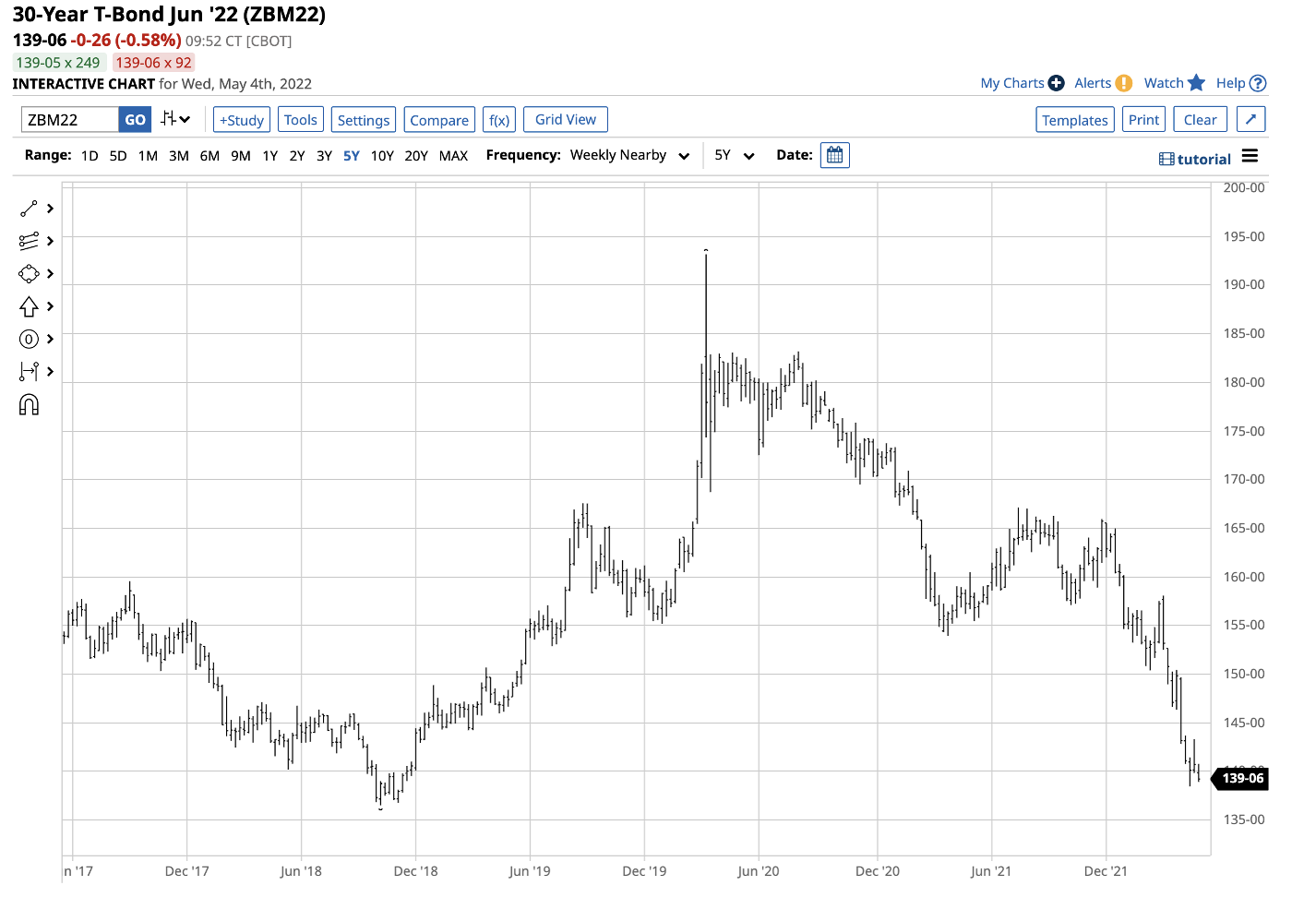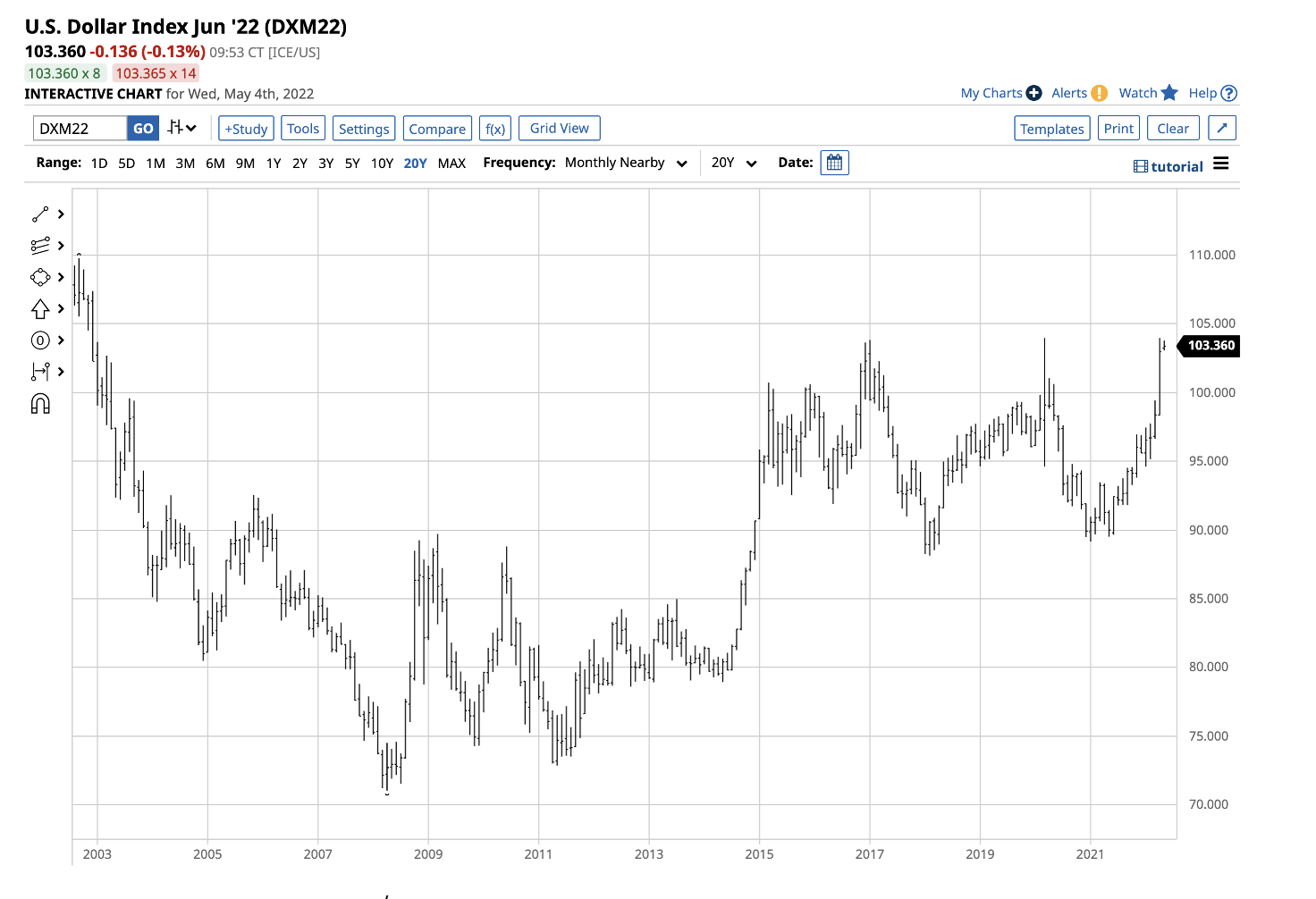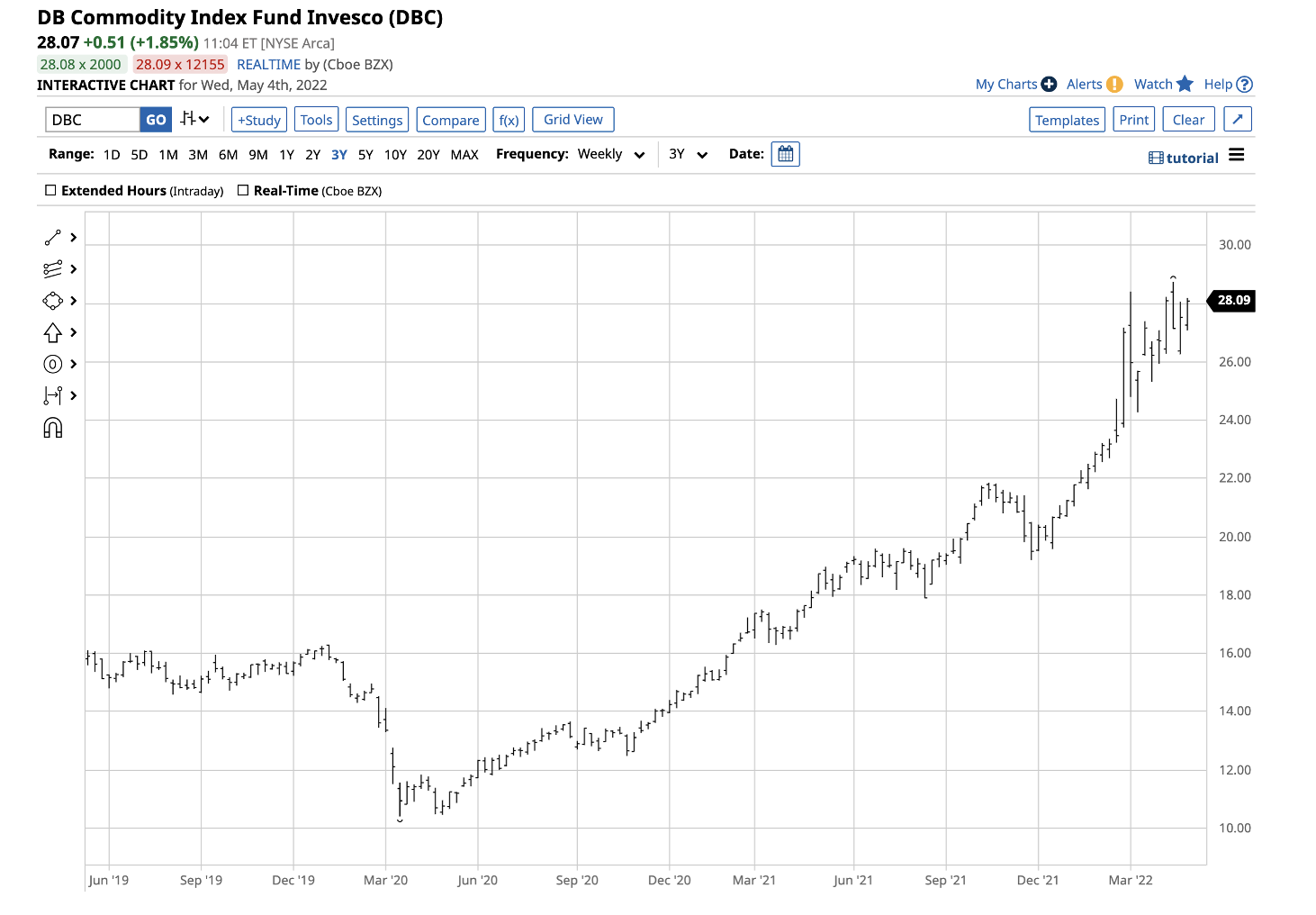Gevo shares jump as Q3 results top estimates, posts positive EBITDA
This article was written exclusively for Investing.com
- The bond market has already moved
- 2 reasons why higher interest rates tend to weigh on commodity prices
- 3 reasons why this time is different
- A kneejerk selloff is likely
- Buy the dip: Look to DBC ETF
In early 2020, as the global pandemic gripped markets across all asset classes, lockdowns created conditions that pushed commodity prices to multi-year lows. Energy, metals, agricultural and industrial raw material prices plunged, but the selling was short-lived.
Central banks pushed interest rates to artificially low levels using all the tools in their monetary policy toolboxes to stabilize the global financial system. Governments handed out stimulus to displaced workers and businesses and spent fortunes to develop vaccines and treatments. The pandemic’s price tag was unprecedented, and it planted inflationary seeds that began to sprout during the second half of 2020.
In 2021, inflation was booming, but blaming the economic condition on “transitory” factors delayed the tough medicine necessary to stop the inflationary spiral. In November and December 2021, the Fed had an epiphany, realizing that inflation was structural, it shifted to a more hawkish approach to monetary policy. However, the central bank did not end quantitative easing until early March 2022, the same time as it lifted from its 0% Fed Funds rate as CPI moved to 8.5%, the highest level in more than four decades, and PPI rose 11.2%.
Inflation has been bullish for commodity prices, pushing them from the 2020 lows to multi-year highs—and in some cases, all-time highs in 2021 and early 2022. With the Fed prepared to take some tough medicine, commodities are sitting a lot closer to the highs than the lows. Inflation and rising interest rates are not the only issues facing the commodities asset class in early May 2022. The first major war in Europe since WW II has created significant distortions in the fundamental equations for many raw material markets.
Bond Market Has Already Moved
The Federal Reserve will struggle to keep pace with the bond futures market. On May 4, the FOMC raised the short-term Fed Funds Rate by 50 basis points, and more hikes are expected to follow over the coming months. A balance sheet reduction program will impact rates further out along the yield curve, pushing them higher, but the market will determine medium- and long-term rates based on the supply and demand for bonds.
Meanwhile, the bond market has been in a bearish trend since mid-2021.

Source: Barchart
The chart highlights the decline in the U.S. 30-year Treasury bond futures that reached the latest 138-14 low on Apr. 20. The first level of technical support stands at the October 2018 136-16 low.
The Fed Funds rate was boosted to the 0.75% to 1.00% on May 4, and it will take many more rate hikes to keep up with the bond futures market. Moreover, with March CPI and PPI at the highest levels since the early 1980s, the central bank remains far behind the inflationary curve, with real interest rates in negative territory.
2 Reasons Why Higher Interest Rates Tend To Weigh On Commodity Prices
Rising U.S. interest rates tend to be bearish for commodity prices because they increase the cost of carrying inventories. In a rising interest rate environment, consumers of raw materials tend to purchase requirements on a hand-to-mouth basis, passing along higher prices to retail consumers.
Rising interest rates also increase the U.S. dollar’s value compared with other world reserve currencies.

Source: Barchart
The U.S. dollar index chart shows the currency moved to 103.95 last week, only 0.01 shy of the March 2020 high, which was the highest level for the dollar in two decades, since 2002.
The U.S. dollar is the world’s reserve currency and the pricing mechanism for most commodities. A higher dollar tends to weigh on commodity prices as they rise in other currency terms. The cure for higher prices is high prices as consumers seek substitutes or limit purchases, weighing on the overall demand.
Over the past weeks, we have seen commodity prices decline from multi-year or all-time highs. Crude oil fell from over $130 per barrel, and gold dropped from $2,072 to the $1,860 level. Copper fell from just over $5 per pound to the $4.20 level. Most commodities have corrected on the back of rising rates and a strong U.S. dollar.
3 Reasons Why This Time Is Different
Increasing interest rates and a rising U.S. dollar are typically bearish for the commodities asset class. However, 2022 is anything but an ordinary time in history. Three factors could make interest and currency rates take a backseat over the coming weeks and months:
- The war in Ukraine, sanctions on Russia, and retaliation are causing supply distortions impacting prices in the commodities asset class.
- The “no-limits” alliance between China and Russia creates an ideological bifurcation between the world’s nuclear powers, with the U.S. and Europe on the other side. With the U.S. and China on opposite sides of the ideological divide, the tensions between the world’s two leading economies create a financial conflict.
- Pandemic-inspired supply-chain bottlenecks and war-inspired logistical challenges interfere with transporting commodities from producers to consumers, creating shortages in some regions and gluts in others.
Meanwhile, the war and dramatic shift in the geopolitical landscape have incited other factors that fuel global inflationary pressures. Russia recently declared that one gram of gold back 5,000 rubles in a return to a gold standard. If China follows, it will have substantial consequences for the worldwide financial system. Saudi Arabia and Nigeria are discussing selling crude oil to China for payment in Chinese yuan, and Russia is demanding that European energy consumers pay for fossil fuels in rubles. The changes threaten the U.S. dollar’s position as the world’s reserve currency, which would weigh on the dollar’s value. The dollar index measures the dollar value against the euro, Japanese yen, British pound, Canadian dollar, Swedish krona and Swiss franc. However, it does not measure the dollar’s purchasing power, which has declined along with all other fiat currencies.
A Kneejerk Selloff Likely
While the Fed boosted interest rates by 50 basis points, negative GDP data, which saw the indicator fall by 1.4%, threatens stagflation, rising prices, and declining economic activity. Stagflation puts the central bank in a challenging position as higher rates potentially further choke economic growth. While we may see kneejerk selling after the Fed meeting, the war in Ukraine causing price distortions, the falling status of the U.S. dollar, and overall bullish trends in raw material prices could create lots of volatility as the market digests the FOMC’s first significant hawkish move in years.
The Fed is caught between the highest inflation in more than four decades and a slowing economy. The central bank will look back at 2021 as an opportunity lost for addressing inflation as it was asleep at the wheel. In May 2022, the situation is far more complicated as the war in Ukraine and ideological bifurcation are far more significant for the global economy than U.S. interest rates.
Buy The Dip: Look To DBC ETF
I believe any significant further selloff in commodity prices will be a buying opportunity. If the 2008 financial crisis is a model for the 2020 global pandemic, commodity prices continued to rise until 2011, three years later. We may only be in the middle innings of the post-pandemic commodity rally, created by central bank liquidity, government stimulus, and a delayed reaction by the Fed to tighten credit when it had the chance.
Moreover, the levels of liquidity and stimulus in 2020 and 2021 were far higher than in 2008 and 2009, and the world did not have to deal with the first major war in Europe since World War II that is causing significant changes in the supply and demand fundamentals for all commodities. The shift in U.S. energy policy in early 2021 only complicates matters as it returned the pricing power for fossil fuels to OPEC and Russia, cementing their relationship at the expense of the U.S. and European relations with the world’s leading oil and gas producers.
I continue to favor the commodities asset class. I believe the current correction and the potential for lower prices on the back of higher U.S. rates and the dollar will create a compelling buying opportunity.
A liquid and diversified commodity-based ETF product with weighting towards energy is the Invesco DB Commodity Index Tracking Fund (NYSE:DBC). At just over the $28 per share level, DBC had over $4.439 billion in assets under management. The ETF trades an average of over 4.59 million shares each day and charges a 0.87% management fee.

Source: Barchart
The chart shows DBC rose from $10.41 per share in March 2020 to the most recent high of $28.75 on Apr. 18. At $28.07 per share, the ETF is near the high. In 2008, DBC reached an all-time peak of $46.63 per share. I expect DBC to continue its path of higher lows and higher highs over the coming months. Any substantial correction could be a golden buying opportunity in the product that moves higher and lower with commodity prices.
The Fed may want to address inflation, but geopolitical events are at the center of the stage. The U.S. central bank has no tools to deal with the ideological bifurcation that will fuel inflationary pressures.
Interested in finding your next great idea? InvestingPro+ gives you the chance to screen through 135K+ stocks to find the fastest growing or most undervalued stocks in the world, with professional data, tools, and insights. Learn More »
